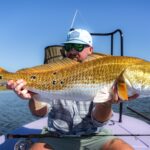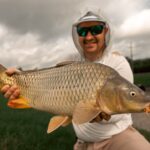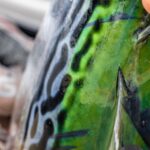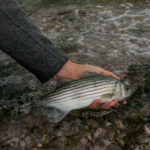
Louisiana Bull Reds Up for Harvest Again: H.B. 604 Must Not Pass
Photo Credit: Carter Abramson | Trevor Johnson Every now and then, we encounter something so
The Striped Bass Board Meeting on Wednesday will review the results of the stock assessment update. Technical Committee conclusions (or lack thereof) and Board decisions have huge implications on rebuilding the stock and the long-term sustainability of this resource. The 2024 Annual ASMFC Meeting is a big one, with many other agenda items and discussions including Menhaden reports, new cobia measures, and a new approach for setting recreational measures for the likes of black sea bass, scup, summer flounder and bluefish. The following provides an overview of meeting topics for our advocates:
Striped Bass: The Elephant in the Room
We wrote extensively about striped bass and also just published a podcast with questions and answers about the stock. These resources are lengthy but intended to be comprehensive. You can also read our Official letter to the Board and see the list of signatories. The sobering Chesapeake Bay Striped Bass Young of the Year survey results (six consecutive years of failed spawns, a historic low) will be a topic of discussion and, hopefully, guide Board Members towards conservation and precautionary management. While this portion of the blog will provide top-lines, you can learn more about the striped bass meeting and potential decision scenarios in this blog from a couple of weeks ago.
At 1:30PM on October 23rd, the Board will review the results of the 2024 Striped Bass Stock Assessment. Spoiler alert: it is very bad. Striped bass will not rebuild without major management changes. Unfortunately, there was uncertainty in the Assessment’s projections; the Technical Committee could not definitively settle on what removals in 2024 and 2025 will look like as the 2018-year class recruits into the slot limit. Assuming removals increase or remain low results in either a 4% or 46% reduction to rebuild by 2029. That disparity in scale of required reductions leaves the Board with a lot of discretion, and it is ultimately the final opportunity we will give this group to take this situation seriously. As we said in our letter, we demand the Board to take action to protect the long-term health of this stock.
The goal for representatives from Maryland, Virginia, Delaware, and New Jersey will be to stall so they can facilitate one more year of killing before the inevitable happens. They will say things like, “we need the 2024 data”. All they need to do is stall until the February meeting and the commercial tags are handed out. At that point, there is no turning back. We hope other Commissioners see through these charades and stand up for the resource.
NJ and MD will lead the charge for no-targeting closures as well. First, these representatives have zero interest in conserving the resource. They are playing a shell game to move dead fish from one column to another. If New Jersey cares about conservation, they can end the bonus tag system. Does NJ expect us to believe that only 9000 fish were harvested with their May-December bonus tag program for 24-28” fish? NJ is the only state that can kill two fish, yet they expect us to believe they are waving the banner of conservation. Let the record show they are not.
New Jersey has no saltwater fishing license which means they have very little funds for conservation enforcement. New Jersey reported 1100 bonus tag fish in THE ENTIRE YEAR FOR 2018. They reported over 9700 in 2023, which equates to around ~45 fish harvested per day. The fact that they reported an average of about 5 fish per day in 2018 is even harder to swallow. This egregious under-reporting impacts the assessment of this fishery. Maryland’s track record for striper conservation is not much better. The state has all but given the Chesapeake over to commercial fishing. Recreational fisherman can’t fish in April or large parts of the summer and commercial fishing goes on with zero reductions in harvest.
This is the last chance this board has to maintain a shred of faith. Take significant action on the 23rd.
Monday, October 21st
Day 1 of the meeting is light, but the ASGA team will be paying attention to the Atlantic Coastal Cooperative Statistics Program Coordinating Council agenda item. During this meeting, we will see a presentation about projects proposals for 2025, which include a variety of fisheries problems and potential solutions. Notable, we’re interested in how the Coordinating Council receives a GotOne project proposal that ASGA collaborated on: “Enhancing and Modernizing Recreational Fisheries Data Collection through Crowd-Sourced Citizen Science, Remote Sensing, and Emerging AI Technology Via the GotOne Fishing App.” ASGA is very excited and and optimistic about the prospect of utilizing GotOne and other emerging technologies to improve recreational fishing data.
Tuesday, October 22nd
Day 2 of the meeting begins with the Sciaenids Board which will review the 2024 Red Drum Stock Assessment (SEDAR 95) and consider potential management responses. Red drum are assessed as two stocks: a Northern (NJ-NC) and a Southern stock (SC-FL). According to the assessment, The Southern stock is in serious need of management with a decade of poor recruitment as well as low Spawning Potential Ratio while overfishing was occurring. There are also concerns for the Northern stock. Look for an Amendment to be initiated. This is the third most important fish on the East Coast and it is in desperate need of conservation.
Later on Tuesday, the Coastal Pelagics Board convenes, and agenda items of note include modifying cobia measures. Cobia are now managed through two regions and harvest targets: a Northern region (RI-VA) and a Southern (NC-GA). The harvest target accounting for the Northern region resulted in an overage, so a reduction is required (Cobia supplemental document). This was widely known even before the adoption of Addendum II and new recreational allocation framework. Mainly due to Virginia harvests, the Northern region went over the target by 10,000 fish and thus needs a 15.9% reduction. Here are the options for new measures:

Cobia effort in the Chesapeake region is certainly expanding, and now managers must grapple with that effort increase and angler efficiency to keep this fishery sustainable. We were pleased with the new framework in Addendum 2 that keeps bag limits standardized across the two regions; this should improve the data quality and bring some regional consistency to this stock that is exhibiting some notable range shifts/expansion.
Next up is Menhaden with several important discussions: review update from Work Group on Precautionary Management in Chesapeake Bay, consider 2023 Fishery Management Plan Review, and an update on the 2025 Ecological Reference Point Benchmark Stock Assessment. We will be paying close attention to the precautionary management in the Chesapeake Bay discussion. You may recall that this Work Group came out of the August meeting with the following unanimous motion:
“Move to establish a Board workgroup to consider and evaluate options for further precautionary management of Chesapeake Bay menhaden fisheries, including time and area closures to be protective of piscivorous birds and fish during critical point of their life cycle.”
The Work Group developed a problem statement and we hope the Board will provide more direction and start a management action to do something precautionary with this crucial forage fish. While menhaden are not overfished or subject to overfishing on a coastwide basis, we do not have data for the Chesapeake Bay specifically, where over 75% of the harvest takes place.
Thursday, October 24
The final discussion we’re paying close attention to is a joint-meeting with the Mid-Atlantic Fishery Management Council regarding a new approach to setting recreational management measures for black sea bass, summer flounder, scup, and bluefish. The “Recreational Measure Setting Process” is the second iteration of the Harvest Control Rule action from a couple of years ago, and we remain cautiously skeptical. At this meeting, the Commission and Council will approve this Framework/Addendum and alternatives for public comment.
Without a doubt the management of these species has been challenging. Biomass estimates for black sea bass and scup remain very high, but measures are consistently becoming more restrictive; there does seem to be a disconnect with what people are seeing on the water (in certain regions) and what the measures are. However, recreational catch limits, which are derived with the best available scientific information, have been consistently exceeded. These new approaches seek to set measures using additional information and/or analyses, noting the variability and precision/accuracy of recreational fisheries data. While that sounds good on paper, we remain concerned how these approaches could result in negative stock status determinations (overfished or overfishing) and threaten the long-term sustainability of these fisheries. We are also very concerned about the inclusion of bluefish in these actions, because bluefish are not like the other three in terms of fishery motivations. Not to mention, they remain in a rebuilding plan. ASGA is open to exploring new fisheries management frameworks, but will be examining the alternatives very closely. As this action progresses and public hearings are scheduled, we will share more detailed thoughts, so keep an eye out for an in-depth blog.
We encourage our community to attend webinar meetings to learn more about how your favorite fisheries and our shared marine resources are managed. The full lineup of meetings and links to attend are available by clicking here. You may also access through the following methods:
Webinar: https://attendee.gotowebinar.com/register/9011130451108002141
Webinar ID: 565-353-915
Call in: +1.562.247.8422, access code 953-170-135
A PIN will be provided to you after joining the webinar. For those who will not be joining the webinar
but would like to listen in to the audio portion only, press the # key when asked for a PIN.

Photo Credit: Carter Abramson | Trevor Johnson Every now and then, we encounter something so

This past weekend, ASGA proudly sponsored the Dirty Carp Tournament in Louisiana — and no, you didn’t misread that.

After years of data pouring in from The Albie Project, advocacy, persistence, and support from

This morning, the Connecticut Environment Committee held a hearing on House Bill 6248, a bill
We rely on our members and donations to keep fighting for a sustainable tomorrow in marine conservation.
GIVE THE GIFT OF FISHERIES CONSERVATION THIS HOLIDAY SEASON. SHOP ASGA GOODS THAT FUND FISHERIES RESEARCH & ADVOCACY CAMPAIGNS
JOIN ASGA IN CALLING FOR CRITICAL MANAGEMENT ACTION AFTER YEARS OF SPAWN FAILURES & POOR MANAGEMENT.
By using this website, you agree to our use of cookies. We use cookies to provide you with a great experience and to help our website run effectively. To learn more, please review our privacy policy.
One Response
Thank you for keep us up- to-date.